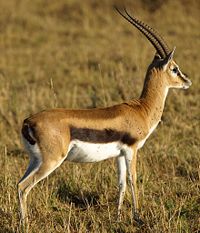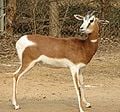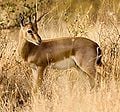Gazelle
| Gazelle | ||||||||||||||
|---|---|---|---|---|---|---|---|---|---|---|---|---|---|---|
 Thomson's Gazelle
| ||||||||||||||
| Scientific classification | ||||||||||||||
| ||||||||||||||
|
Several, see text |
Gazelle is the common name for any of the various small, swift antelopes of Africa and Asia comprising the genus Gazella and the related genera Eudorcas and Nanger, characterized by a slender neck, long legs, and curved, lyre-shaped horns that are upturned at the ends and tend to be heavily ringed. The members of Eudorcas and Nanger used to be included within Gazella, when these were considered subgenera, and in some taxonomies the species remain in Gazella (ITIS 2006). While these are the "true gazelles," three closely related species, comprising the genus Procarpa, also are widely referred to as gazelles.
graceful
ver swift,
Overview and description
As antelopes, gazelles are slender-built and swift bovids (even-toed ungulates of the family Bovidae) with hollow and lightweight horns. Gazelles are known as swift animals. The Thomson's gazelle (Eudorcas thomsonii) is reported to reach a speed of about 50 miles per hour (80 kilometers per hour)(Darcy 2006).
Gazelles are mostly found in the grasslands and savannas of Africa, but they are also found in southwest Asia. They tend to live in herds and will eat less coarse, easily digestible plants and leaves.
A recognizable example of the gazelle is Thomson's gazelle, which is around 60 to 90 centimeters (23 to 35 inches) in height at the shoulder and is colored brown and white with a distinguishing black stripe. The males have long, often curved, horns. Tommies, as they are familiarly called, exhibit a distinctive behavior of stotting (running slowly and jumping high before fleeing) when they are threatened by predators such as lions or cheetahs.
Speke's Gazelle (Gazella spekei) is the smallest of the gazelle species. Partially sympatric with G. gazella pelzini, it is confined to the horn of Africa where it inhabits stony brush, grass steppes, and semi deserts (Kingdom 1982, 1997).
he Mountain Gazelle (Gazella gazella) is a species of gazelle that is widely but unevenly distributed across the Arabian Peninsula. It inhabits mountains, foothills and coastal plains. Its range coincides closely with that of the acacia trees that grow in these areas. It is mainly a grazing species, though this varies with food availability.
The Dama Gazelle (Nanger dama; formerly Gazella dama), also known as the Addra Gazelle, is a species of gazelle. It lives in Africa in the Sahara desert and migrates south in search of food during the dry season. After the rains return and the desert plants turn green, they move north back to the Sahara.
The Grant's Gazelle (Nanger granti) is a species of gazelle. Their populations are distributed from northern Tanzania to southern Sudan and Ethiopia, and from the Kenyan coast to Lake Victoria. The Grant's Gazelle looks similar to a Thomson's Gazelle except it has lyre-shaped horns are stout at the base, clearly ringed and measuring 18 to 32 inches long.
The Dorcas Gazelle غزال(Gazella dorcas), also known as the Ariel Gazelle, is a small and common gazelle. The Dorcas Gazelle stands approximately 53 cm (21 inches) tall. The numerous subspecies of the Dorcas Gazelle survive on vegetation in grassland, steppe, wadis, mountain desert and in semi-desert climates of Africa, Arabia and into Iran and northern India. About 35,000 - 40,000 exists in wild.
Procapra refers to the genus of gazelles[1] and includes
- Mongolian Gazelle Procapra gutturosa
- Tibetan Gazelle Procapra picticaudata
- Przewalski's Gazelle Procapra przwalskii
The Mongolian gazelle (Procapra gutturosa), or Zeren, is a medium-sized antelope native to the semi-arid Central Asian steppes of Mongolia, as well as some parts of Siberia and China. They also have a distinctive heart-shaped white patch on their rump area. The males have lyre-shaped horns which curl backwards from the forehead.
The Goa (Procapra picticaudata), also known as the Tibetan Gazelle, is a species of antelope that inhabits the Tibetan plateau. A typical goa stands about two feet (60cm) tall at the shoulder and weighs about 15kg. Males have long, tapering, ridged horns, reaching lengths of up to 14 inches (35cm). Females have no horns; neither have distinct facial markings.
Przewalski's Gazelle (Procapra przewalskii) is a member of the Bovidae family and, in the wild, is found only in China. Once widespread. its range has declined to 4 populations near Qinghai Lake. The Przewalski's gazelle was named after Nikolai Przhevalsky, a Russian adventurer who collected a specimen and brought it back to St. Petersburg in 1875.[1]
The animal is yellowish brown with white spots on its rump, with a body length of 100 cm, tail of 7–10 cm and a weight of around 21–32 kg. Males are the only ones that bear antlers, which bend inwards at the tips
Procapra|231672384|Mongolian_gazelle|241204824|Przewalski's_Gazelle|214853174|Mountain_Gazelle|244662648
Species[2]
Members of the Artiodactyla order are principally distinguished by the foot; they have an even number of toes (the bovid family comprises 6 genera and 12 species). The taxonomy of these genera is a confused one, and the classification of species and subspecies has been an unsettled issue. Three species—the Red Gazelle, the Arabian Gazelle, and the Queen of Sheba's Gazelle—are extinct. All other gazelle species are listed as endangered, to varying degrees.
- Genus Gazella
- Subgenus Gazella
- Mountain Gazelle, G. gazella
- Neumann's Gazelle, G. erlangeri
- Speke's Gazelle, G. spekei
- Dorcas Gazelle, also known as Ariel Gazelle, G. dorcas
- Saudi Gazelle, G. saudiya
- Chinkara, also known as Indian Gazelle, G. bennettii
- Subgenus Trachelocele
- Cuvier's Gazelle, G. cuvieri
- Rhim Gazelle, G. leptoceros
- Goitered Gazelle, G. subgutturosa
- Subgenus Gazella
- Genus Eudorcas
- Thomson's Gazelle, E. thomsonii
- Red-fronted Gazelle, E. rufifrons
- Genus Nanger
- Dama Gazelle, N. dama
- Grant's Gazelle, N. granti
- Soemmerring's Gazelle, N. soemmerringii
Extinct
Fossils of genus Gazella are found in Pliocene and Pleistocene deposits of Eurasia and Africa. The tiny Gazella borbonica is one of the earliest European gazelles, characterized by its small size and short legs. Gazelles disappeared from Europe at the start of Ice Age, but they survived in Africa and Middle East. Three species become extinct in recent times due to human causes.
Recent extinctions
- Genus Gazella
- Subgenus Gazella
- Arabian Gazelle, G. arabica
- Queen of Sheba's Gazelle, G. bilkis
- Subgenus Gazella
- Genus Eudorcas
- Red Gazelle, E. rufina
Prehistoric extinctions
- Genus Gazella
- Gazella borbonica - European Gazelle
- Gazella thomasi' - Thomas's Gazelle
- Gazella praethomsoni
- Gazella negevensis
- Gazella triquetrucornis
- Gazella negevensis
- Gazella capricornis
- Gazella mytilinii
- Subgenus Vetagazella
- Gazella sinensis
- Gazella deperdita
- Gazella pilgrimi- Steppe Gazelle
- Gazella leile - Leile's Gazelle
- Gazella praegaudryi - Japanese Gazelle
- Gazella gaudryi
- Gazella paotehensis
- Gazella dorcadoides
- Gazella altidens
- Gazella mongolica - Mongolian Gazelle
- Gazella lydekkeri - Ice Age Gazelle
- Gazella blacki
- Gazella parasinensis
- Gazella kueitensis
- Gazella paragutturosa
- Subgenus Gazella
- Gazella janenschi
- Subgenus Trachelocele
- Gazella atlantica
- Gazella tingitana
- Subgenus Deprezia
- Gazella psolea
- Genus Nanger
- Nanger vanhoepeni
Gallery
- Thompson's Gazelle.jpeg
Thomson's Gazelle
ReferencesISBN links support NWE through referral fees
- ↑ Myers, P., R. Espinosa, C. S. Parr, T. Jones, G. S. Hammond, and T. A. Dewey. 2008. The Animal Diversity Web (online). Accessed May 31, 2008 at http://animaldiversity.org
- ↑ Antilopinae. Retrieved 2008-07-01.
Antelope Specialist Group (2007). Gazella spekei. 2007 IUCN Red List of Threatened Species. IUCN 2007. Retrieved on 12 September 2007. Listed as Endangered (EN C1 v2.3) http://www.iucnredlist.org/details/8975
IUCN 2008. 2008 IUCN Red List of Threatened Species. <www.iucnredlist.org>. Downloaded on 16 October 2008.
2008 Assessor/s Heckel, J.-O., Amir, O.G., Kaariye, X.Y. & Wilhelmi, F.
Darcy, P. 2006 [1])
http://www.itis.gov/servlet/SingleRpt/SingleRpt?search_topic=TSN&search_value=624969 Gazella Blainville, 1816 Taxonomic Serial No.: 624969
Credits
New World Encyclopedia writers and editors rewrote and completed the Wikipedia article in accordance with New World Encyclopedia standards. This article abides by terms of the Creative Commons CC-by-sa 3.0 License (CC-by-sa), which may be used and disseminated with proper attribution. Credit is due under the terms of this license that can reference both the New World Encyclopedia contributors and the selfless volunteer contributors of the Wikimedia Foundation. To cite this article click here for a list of acceptable citing formats.The history of earlier contributions by wikipedians is accessible to researchers here:
The history of this article since it was imported to New World Encyclopedia:
Note: Some restrictions may apply to use of individual images which are separately licensed.






